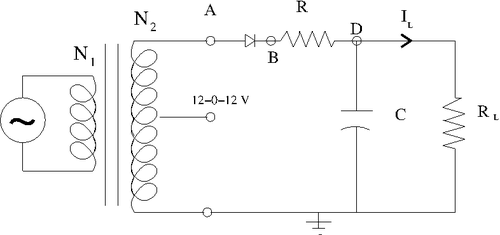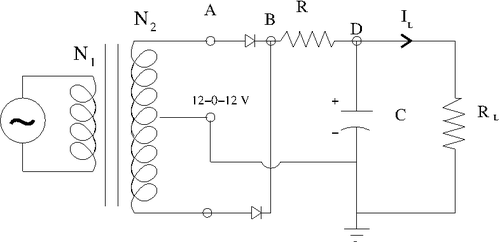Difference between revisions of "Lab 10 RS"
| Line 70: | Line 70: | ||
Because we are now using <math>(\Delta t/2)</math> instead of <math>(\Delta t)</math> than in previous case for half-wave rectifier theoretiacally we will be able to make <math>\Delta V</math> two times less then in previous case just by using exactly the same ellements and input parameters as before: | Because we are now using <math>(\Delta t/2)</math> instead of <math>(\Delta t)</math> than in previous case for half-wave rectifier theoretiacally we will be able to make <math>\Delta V</math> two times less then in previous case just by using exactly the same ellements and input parameters as before: | ||
| − | |||
| − | |||
Revision as of 15:29, 8 March 2011
Lab 10 Unregulated power supply
Use a transformer for the experiment.
here is a description of the transformer.
File:TF EIM 241 transformer.pdf
Half-Wave Rectifier Circuit
1.)Consider building circuit below.
Determine the components needed in order to make the output ripple have a less than 1 Volt.
The output ripple can be found by
Taking AC signal from outlet equals to my input pulse width is and using say I need my current to be:
Taking
that satisfy the condition above for current so my output ripple becomes less than 1 Volts.
List the components below and show your instructor the output observed on the scope and sketch it below.
I have used the following components:
and the following input parameters:
The current through the circuit can be found as
where
.
And the current becomes
So my output ripple becomes
Full-Wave Rectifier Circuit
Determine the components needed in order to make the above circuit's output ripple have a less than 0.5 Volt.
The output ripple in this case can be found by
Because we are now using instead of than in previous case for half-wave rectifier theoretiacally we will be able to make two times less then in previous case just by using exactly the same ellements and input parameters as before:
List the components below and show your instructor the output observed on the scope and sketch it below.
Go Back to All Lab Reports Forest_Electronic_Instrumentation_and_Measurement

